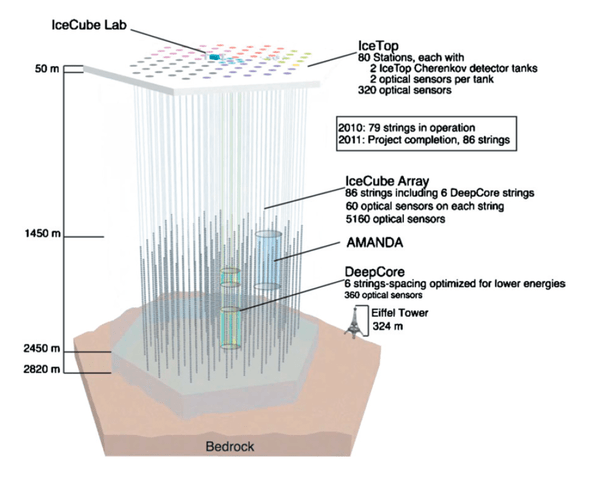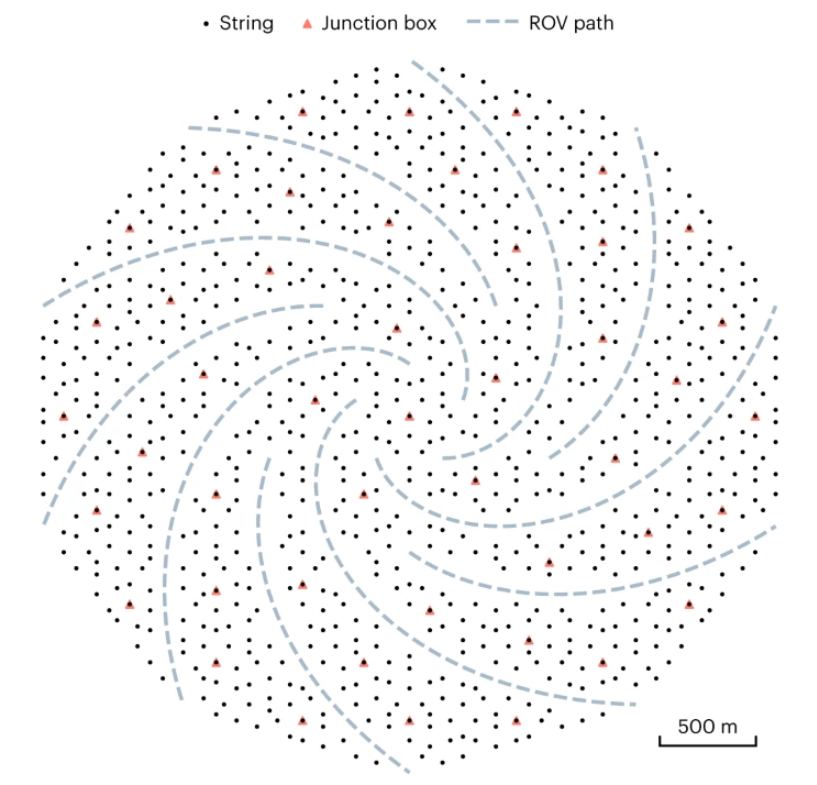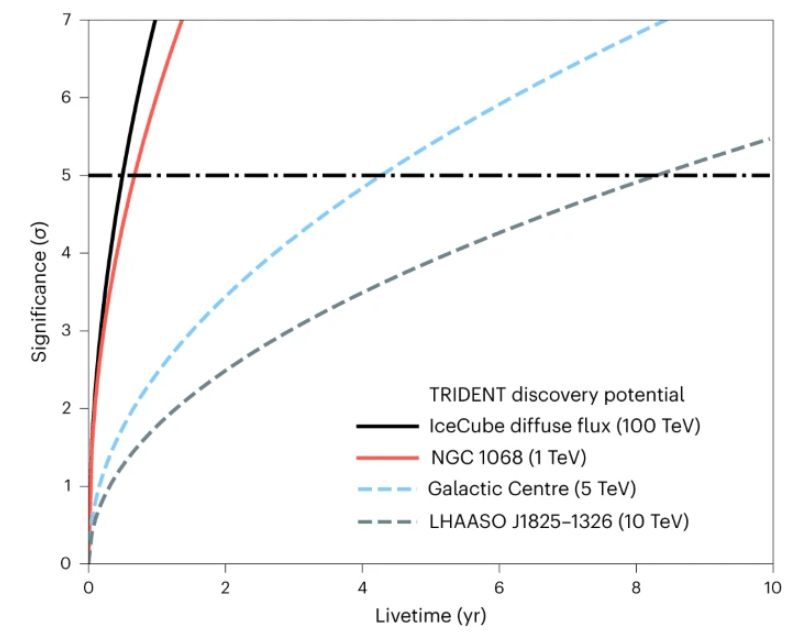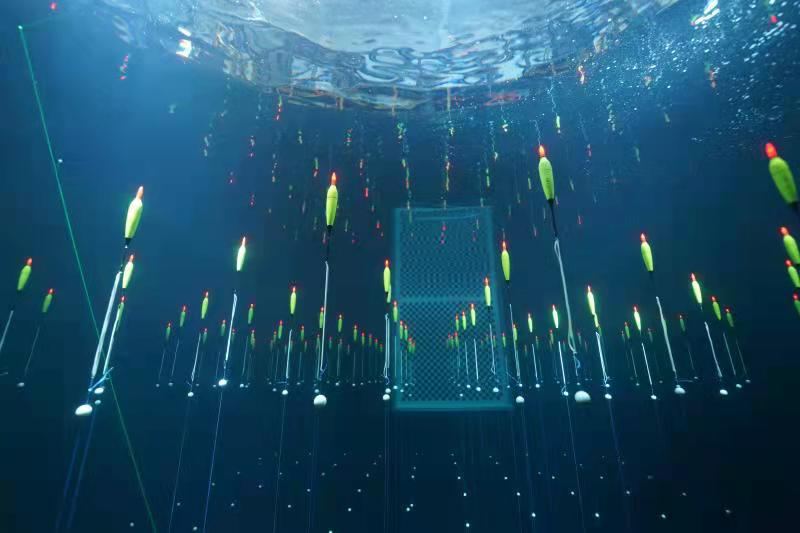China is building a new neutrino detector named TRIDENT, the Tropical Deep-sea Neutrino Telescope. They’re building it in the South China Sea, near the equator. This next-generation neutrino telescope will feature improved sensitivity and should help clear up the mystery around cosmic rays and their origins.
Cosmic neutrinos are fleet-of-foot messengers from the distant cosmos. They’re very difficult to detect and can only be detected on the rare occasions when they interact with other matter.
A new paper in Nature Astronomy presents plans for China’s new neutrino observatory. It’s “A multi-cubic-kilometre neutrino telescope in the western Pacific Ocean,” and the lead author is Ziping Ye, a Postdoctoral Fellow in the Particle and Nuclear Division at the Tsung-Dao Lee Institute at Shanghai Jiao Tong University, Shanghai, China.
‘Neutrino’ means ‘little neutral one,’ and unless you’re a physicist, a primer on neutrinos is helpful.
Neutrinos—and there are three sub-types—were discovered in the early 20th century. They have no electrical charge and an infinitesimal mass. In fact, some physicists initially thought they were massless. Without a charge, they don’t interact with the electromagnetic force. They only interact through gravity and the weak nuclear force.
Neutrinos pass right through the Earth. Most of them come from the Sun, which bombards every square center of the Earth that’s facing the Sun, with 65 billion of them every second. They have other sources, too, including supernovae, nuclear reactors, and other things, including the Big Bang.
But the study of cosmological neutrinos is most important to us, and that’s what China’s new TRIDENT observatory is concerned with. Cosmological neutrinos are created when cosmic rays strike atoms.
Neutrinos are evasive, and that means detectors have to outwit them. They’re placed in deep, abandoned mines, deep in the ocean, and even deep in the Antarctic ice. Sequestered away in seclusion, these observatories don’t sense neutrinos themselves. Instead, they observe the result of the rare neutrino that interacts with regular matter.
Neutrinos may be evasive, but their evasiveness also works in our favour.
Scientists are keen to pinpoint the sources of ultra-high energy cosmic rays. They can do it by detecting neutrinos, which are accelerated to relativistic speeds by extragalactic objects like the jets shooting out from active galactic nuclei (AGN.) Since neutrinos seldom interact with anything, they travel on long, straight paths, even through dense environments, without swerving. If you can detect them, you can track them to their sources.
Most neutrino observatories are made of massive volumes of water or ice. The observatories consist of strings of linked detectors. Have a look at the IceCube Neutrino Observatory for an example.

China’s new TRIDENT neutrino observatory will consist of 1,211 strings, each containing 20 hDOMs, hybrid digital optical modules, separated vertically by 30 m, ranging from approximately 2,800 m to 3,400 m below sea level.

Volume is one key to successful neutrino detection. The larger the volume of water the observatory monitors, the higher the probability there is for it to detect rare neutrino interactions. TRIDENT will be the world’s largest neutrino detector, with a volume of about 7.5 km3. Compare that to the IceCube Neutrino Observatory with its approximately one km3 of volume.
Detector efficiency is another main consideration. TRIDENT will have unprecedented photon detection efficiency, and when combined with its large volume, it is truly a next-generation neutrino detector. “TRIDENT intends to push the limits of neutrino telescope performance, reaching a new frontier of sensitivity in all-sky searches for astrophysical neutrino sources,” the paper states.
TRIDENT will build on IceCube’s success and will take neutrino science even further. IceCube is known in neutrino-detection circles for discovering one particular extragalactic neutrino source candidate in 2022. It’s NGC 1068, aka Messier 77, aka the Squid Galaxy. It’s a barred spiral about 47 million light years away. It’s an active galaxy, and observations so far show that the neutrinos from M77 may have multiple sources.
“TRIDENT is predicted to discover the steady source NGC 1068 within one year of operation,” the paper states.

Constructing a facility like this is a complex endeavour. Arranging 24,220 connectors on 1211 separate strings in a geometric pattern 2,800 m to 3,400 m below sea level is not easy. Precise global time stamps are necessary to make sense of any detections, and that complicates the system even further. The strings of detectors also have to be anchored to the sea floor, which means any old location won’t do. The South China Sea is a highly dynamic body of water, and the TRIDENT team has identified an abyssal plain in the north part of the sea that meets the neutrino observatory’s stringent requirements. An abyssal plain is a large flat area of the sea floor with a slope of less than 1:1000.
Neutrino sensor arrays are extraordinarily sensitive, and they have to be built to exacting standards. That’s difficult to do in an ocean. TRIDENT has to take into account ocean currents at different depths, natural radiation, and the temperature and salinity of the water. These can all affect observations and need to be accounted for in the observatory’s design.

China has built a simulator at a University in Shanghai to work on their plan. There’s a lot of work yet to do, and China hasn’t given a completion date or a “first light” date.
But China is riding a string of successes when it comes to space and astronomy, including building the world’s largest radiotelescope. Success seems likely.
“The Tropical Deep-sea Neutrino Telescope (TRIDENT), nicknamed Hai-Ling in Chinese (‘ocean bell’), aims to rapidly discover multiple high-energy astrophysical neutrino sources and greatly boost the measurement of cosmic neutrino events of all flavours,” the paper concludes.
The post China Chooses the Site for their TRIDENT Neutrino Detector appeared first on Universe Today.
No comments:
Post a Comment